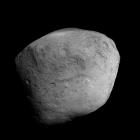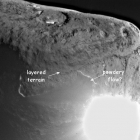Prof. Joseph Veverka to talk about Stardust-NExT
November 10th, 2011
Stardust-NExT: NASA's most traveled comet hunter!
Professor Joseph Veverka of Cornell University will speak at the 11/17/11 Colloquium (4:00PM, Room 105, Space Sciences Bldg., Cornell University) on the successful results of the Stardust-NExT mission.
Stardust-NExT (Stardust-New Exploration of Tempel) was an extended
mission that utilized the already "in flight" Stardust spacecraft to fly
by comet Tempel 1 on Feb. 14, 2011 and extended the investigation of that
comet by the Deep Impact mission. Note - while the mission name has been
changed to Stardust-NExT the spacecraft will continue to be referred to
as "Stardust."
NASA's Jet Propulsion Laboratory, Pasadena, Calif., managed
Stardust-NExT for NASA's Science Mission Directorate, Washington.
Cornell University, New York is home to the mission's principal
investigator, Joe Veverka. The spacecraft was built for NASA by Lockheed
Martin Space Systems, Littleton, Colo.
The primary science objectives of the Stardust-NExT mission were as follows:
- To extend our understanding of the processes that affect the surfaces of comet nuclei by documenting the changes that have occurred on comet Tempel 1 between two successive perihelion passages.
- To extend the geologic mapping of the nucleus of Tempel 1 to elucidate the extent and nature of layering and help models of the formation and structure of comet nuclei.
- To extend the study of smooth flow deposits, active areas, and known exposure of water ice.
- Document the surface changes on a comet’s nucleus between successive perihelion passages.
- Measure Tempel 1’s dust properties and compare with data taken from Comet Wild 2.
- Provide additional information on enigmatic layering and flow features discovered by the Deep Impact mission
- On-board instruments will image the nucleus surface and jets; count dust particles size and distribution during closest approach; and composition of dust for further ground analysis.
Other Objectives:
- If possible, to characterize the crater produced by Deep Impact in July 2005 to better understand the structure and mechanical properties of cometary nuclei and elucidate crater formation processes on them.
- Measure the flux and mass distribution of dust particles within the coma using the DFMI instrument.
- Analyze the composition of dust particles within the coma using the CIDA instrument.
- Monitor comet activity over 60 days on approach using imaging.




